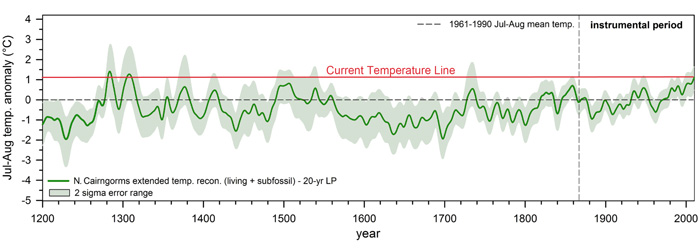| Tweet | Follow @co2science |
Paper Reviewed
Rydval, M., Loader, N.J., Gunnarson, B.E., Druckenbrod, D.L., Linderholm, H.W., Moreton, S.G., Wood, C.V. and Wilson, R. 2017. Reconstructing 800 years of summer temperatures in Scotland from tree rings. Climate Dynamics 49: 2951-2974.
Writing as background for their work, Rydval et al. (2017) say that "despite the existence of a dense network of tree-ring chronologies across Europe, the availability of long tree-ring based temperature reconstructions still remains limited with only a handful of millennial (or near millennial) records existing at present." Thus, they continue, "the development of additional long reconstructions in regions where records are short or do not exist is therefore vital in order to constrain estimates of past temperature variability by reducing spatial and temporal uncertainty and therefore expanding our understanding of climate conditions during the late Holocene." And that was just what this team of eight researchers set out to do.
Focusing on Scotland, which lacks an annually-resolved near-millennial temperature record, Rydval et al. extended "the previously published Scottish dendroclimatic record (Hughes et al., 1984) by nearly 500 years," in order to create an 810-year-long proxy over the period AD 1200-2010. The reconstruction was derived from a network of 44 Scots pine (Pinus Sylvestris) sites across the Scottish Highlands from both living and subfossil samples that correlated well with summer (July-August) temperatures.
As illustrated in the figure below, this reconstruction shows both prominent warm and cold periods. The longest cold period extends from the late sixteenth through the early eighteenth centuries and correlates well with the Little Ice Age, while the five coldest decades in the reconstruction occurred in the 1690s, 1630s, 1220s, 1230s and 1660s.
The five warmest decades, in contrast, were calculated for the 1300s, 1280s, 2000s, 1500s and 1980s and the most extreme individual summer temperatures (the top five warmest years in the record) occurred in 1284, 1285, 1307, 1310 and 1282. In placing the most recent warming of the instrumental period in context, Rydval et al. write that it "is likely not unique when compared to multi-decadal warm periods observed in the 1300s, 1500s and 1730s." And that fact suggests there is nothing unusual, unnatural or unprecedented about the current warmth of Scotland, which further suggests that earth's rising atmospheric CO2 concentration may very well have had no measurable impact on temperature trends there!

Figure 1. Reconstructed (20-year low-pass filtered) Scotland summer (Jul-Aug) temperatures. Red line represents the peak warmth obtained during the instrumental period. Adapted from Rydval et al. (2017).
Reference
Hughes, M.K., Schweingruber, F.H., Cartwright, D. and Kelly, P.M. 1984. July-August temperature at Edinburgh between 1721 and 1975 from tree-ring density and width data. Nature 308: 341-344.




